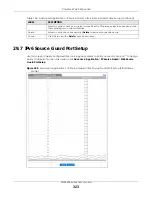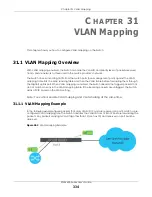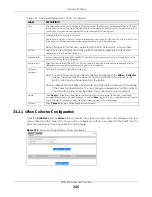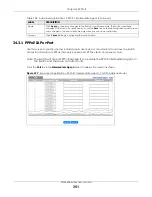
Chapter 31 VLAN Mapping
XGS4600 Series User’s Guide
337
Figure 266
Advanced Application > VLAN Mapping > VLAN Mapping Configuration (Stacking Mode)
The following table describes the labels in this screen.
Table 145 Advanced Application > VLAN Mapping > VLAN Mapping Configuration
LABEL
DESCRIPTION
Active
Check this box to activate this rule.
Name
Enter a descriptive name (up to 32 printable ASCII characters) for identification purposes.
Port
Type a port to be included in this rule. In stacking mode, the first field is the slot ID and the
second field is the port number.
VID
Enter a VLAN ID from 1 to 4094. This is the VLAN tag carried in the packets and will be translated
into the VID you specified in the
Translated VID
field.
Translated VID
Enter a VLAN ID (from 1 to 4094) into which the customer VID carried in the packets will be
translated.
Priority
Select a priority level (from 0 to 7). This is the priority level that replaces the customer priority
level in the tagged packets or adds to the untagged packets.
Add
Click this to create a new entry or to update an existing one.
This saves your changes to the Switch’s run-time memory. The Switch loses these changes if it is
turned off or loses power, so use the
Save
link on the top navigation panel to save your
changes to the non-volatile memory when you are done configuring.
Cancel
Click
Cancel
to reset the fields to your previous configuration.
Index
This is the number of the VLAN mapping entry in the table. Click on an index number to change
the settings.
Active
This shows whether this entry is activated or not.
Name
This is the descriptive name for this rule.
Port
This is the port number to which this rule is applied.
VID
This is the customer VLAN ID in the incoming packets.
Translated VID
This is the VLAN ID that replaces the customer VLAN ID in the tagged packets.
Priority
This is the priority level that replaces the customer priority level in the tagged packets.
Select an entry’s check box to select a specific entry. Otherwise, select the check box in the
table heading row to select all entries.
Delete
Check the rules that you want to remove in the
Delete
column and then click the
Delete
button.
Cancel
Click
Cancel
to clear the
Delete
check boxes.
Содержание XGS4600 Series
Страница 24: ...24 PART I User s Guide ...
Страница 44: ...44 PART II Technical Reference ...
Страница 180: ...Chapter 13 Spanning Tree Protocol XGS4600 Series User s Guide 180 Figure 145 MSTP and Legacy RSTP Network Example ...
Страница 189: ...Chapter 16 Mirroring XGS4600 Series User s Guide 189 Figure 150 Advanced Application Mirroring Standalone Mode ...
Страница 244: ...Chapter 22 Policy Rule XGS4600 Series User s Guide 244 Figure 189 Policy Example EXAMPLE ...
Страница 277: ...Chapter 25 Multicast XGS4600 Series User s Guide 277 Figure 215 Advanced Application Multicast MVR Standalone Mode ...
Страница 559: ...Chapter 59 Access Control XGS4600 Series User s Guide 559 Figure 460 Example Lock Denoting a Secure Connection EXAMPLE ...
Страница 586: ...Chapter 69 Configure Clone XGS4600 Series User s Guide 586 Figure 479 Management Configure Clone Standalone Mode ...
Страница 587: ...Chapter 69 Configure Clone XGS4600 Series User s Guide 587 Figure 480 Management Configure Clone Stacking Mode ...
Страница 594: ...Chapter 71 Port Status XGS4600 Series User s Guide 594 Figure 485 Management Port Status Port Details Standalone Mode ...
Страница 604: ...604 PART III Troubleshooting and Appendices ...
















































